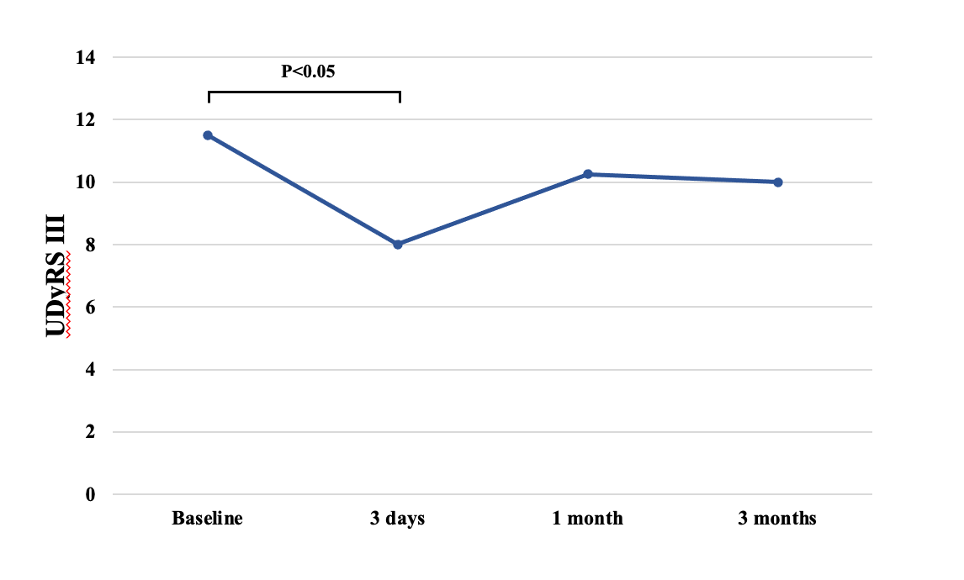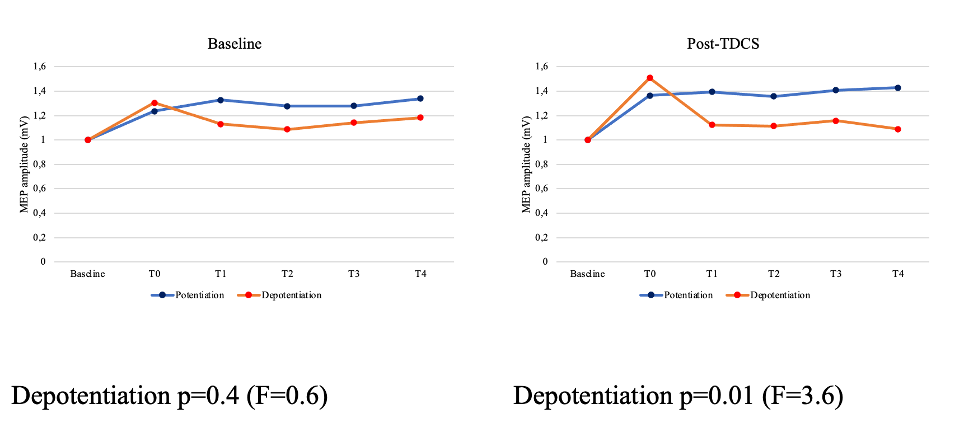Category: Parkinson's Disease: Neurophysiology
Objective: Our study aims to demonstrate the possible effect of transcranial direct current stimulation (tDCS) in the treatment of Levodopa-induced dyskinesias (LIDs) in patients with Parkinson’s Disease.
Background: In Parkinson’s disease (PD), Levodopa is to date the most effective treatment for the management of motor symptoms. However, in a certain number of patients, prolonged treatment is associated with development of Levodopa-induced dyskinesias (LIDs). In the pathophysiology of LIDs, aberrant synaptic plasticity seems to play a key role at different levels of brain system, including the primary motor cortex (M1). Non-invasive brain stimulation (NIBS) may restore normal functioning and ameliorate clinical deficits reversing these brain plasticity abnormalities.
Method: We administered cathodal bilateral tDCS over M1 of 8 PD patients with LIDs, selected according to similar age, disease duration, and levodopa equivalent daily dose (LEDD). Clinical and neurophysiological evaluation were performed before and after stimulation protocol at three different time points (3 days, 1 month and 3 months). Primary endpoint was reduction in LIDs severity measured by UDyRS. Secondary endpoint was improvement in depotentiation degree measured by MEP amplitude changes.
Results: tDCS over bilateral M1 induced a reduction in LIDs of 32% at 3 days, 9% at 1 month, and 9.8% at 3 months compared with baseline. In addition, a significant change in Depotentiation paradigm (p=0.01) was observed in post-tDCS recordings compared with baseline.
Conclusion: In conclusion, this preliminary report shows that, in PD patients with LIDs, cathodal bilateral tDCS over M1 induces a short-term improvement in LIDs severity associated with useful changes in synaptic plasticity.
References: Lefaucheur, J-P., Antal, A., Ayache, S.S., Benninger, D.H., Brunelin, J., Cogiamanian, F., Cotelli, M., De Ridder, D., Ferrucci, R., Langguth, B., Marangolo, P., Mylius, V., Nitsche, M.A., Padberg, F., Palm, U., Poulet, E., Priori, A., Rossi, S., Schecklmann, M., Vanneste, S., Ziemann, U., Garcia-Larrea, L., Paulus, W., Evidence-based guidelines on the therapeutic use of transcranial direct current stimulation (tDCS), Clinical Neurophysiology (2016), doi: http://dx.doi.org/10.1016/j.clinph.2016.10.087
Benninger DH, Hallett M. Non-invasive brain stimulation for Parkinson’s disease: Current concepts and outlook 2015. NeuroRehabilitation 2015;37:11-24.
To cite this abstract in AMA style:
B. Angeloni, R. Di Iorio, F. Bove, P. Sanginario, C. Piano, A R. Bentivoglio, P. Calabresi. The effect of cathodal transcranial direct current stimulation in the treatment of Levodopa-Induced Dyskinesias in Parkinson’s Disease: a preliminary report. [abstract]. Mov Disord. 2023; 38 (suppl 1). https://www.mdsabstracts.org/abstract/the-effect-of-cathodal-transcranial-direct-current-stimulation-in-the-treatment-of-levodopa-induced-dyskinesias-in-parkinsons-disease-a-preliminary-report/. Accessed April 1, 2025.« Back to 2023 International Congress
MDS Abstracts - https://www.mdsabstracts.org/abstract/the-effect-of-cathodal-transcranial-direct-current-stimulation-in-the-treatment-of-levodopa-induced-dyskinesias-in-parkinsons-disease-a-preliminary-report/


